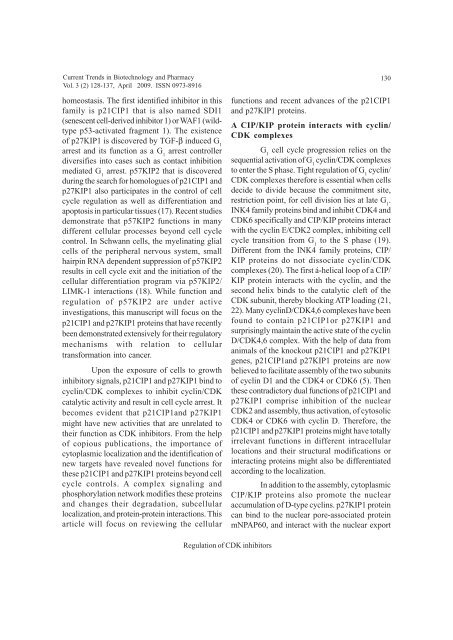April Journal-2009.p65 - Association of Biotechnology and Pharmacy
April Journal-2009.p65 - Association of Biotechnology and Pharmacy
April Journal-2009.p65 - Association of Biotechnology and Pharmacy
You also want an ePaper? Increase the reach of your titles
YUMPU automatically turns print PDFs into web optimized ePapers that Google loves.
Current Trends in <strong>Biotechnology</strong> <strong>and</strong> <strong>Pharmacy</strong><br />
Vol. 3 (2) 128-137, <strong>April</strong> 2009. ISSN 0973-8916<br />
homeostasis. The first identified inhibitor in this<br />
family is p21CIP1 that is also named SDI1<br />
(senescent cell-derived inhibitor 1) or WAF1 (wildtype<br />
p53-activated fragment 1). The existence<br />
<strong>of</strong> p27KIP1 is discovered by TGF-β induced G 1<br />
arrest <strong>and</strong> its function as a G 1<br />
arrest controller<br />
diversifies into cases such as contact inhibition<br />
mediated G 1<br />
arrest. p57KIP2 that is discovered<br />
during the search for homologues <strong>of</strong> p21CIP1 <strong>and</strong><br />
p27KIP1 also participates in the control <strong>of</strong> cell<br />
cycle regulation as well as differentiation <strong>and</strong><br />
apoptosis in particular tissues (17). Recent studies<br />
demonstrate that p57KIP2 functions in many<br />
different cellular processes beyond cell cycle<br />
control. In Schwann cells, the myelinating glial<br />
cells <strong>of</strong> the peripheral nervous system, small<br />
hairpin RNA dependent suppression <strong>of</strong> p57KIP2<br />
results in cell cycle exit <strong>and</strong> the initiation <strong>of</strong> the<br />
cellular differentiation program via p57KIP2/<br />
LIMK-1 interactions (18). While function <strong>and</strong><br />
regulation <strong>of</strong> p57KIP2 are under active<br />
investigations, this manuscript will focus on the<br />
p21CIP1 <strong>and</strong> p27KIP1 proteins that have recently<br />
been demonstrated extensively for their regulatory<br />
mechanisms with relation to cellular<br />
transformation into cancer.<br />
Upon the exposure <strong>of</strong> cells to growth<br />
inhibitory signals, p21CIP1 <strong>and</strong> p27KIP1 bind to<br />
cyclin/CDK complexes to inhibit cyclin/CDK<br />
catalytic activity <strong>and</strong> result in cell cycle arrest. It<br />
becomes evident that p21CIP1<strong>and</strong> p27KIP1<br />
might have new activities that are unrelated to<br />
their function as CDK inhibitors. From the help<br />
<strong>of</strong> copious publications, the importance <strong>of</strong><br />
cytoplasmic localization <strong>and</strong> the identification <strong>of</strong><br />
new targets have revealed novel functions for<br />
these p21CIP1 <strong>and</strong> p27KIP1 proteins beyond cell<br />
cycle controls. A complex signaling <strong>and</strong><br />
phosphorylation network modifies these proteins<br />
<strong>and</strong> changes their degradation, subcellular<br />
localization, <strong>and</strong> protein-protein interactions. This<br />
article will focus on reviewing the cellular<br />
130<br />
functions <strong>and</strong> recent advances <strong>of</strong> the p21CIP1<br />
<strong>and</strong> p27KIP1 proteins.<br />
A CIP/KIP protein interacts with cyclin/<br />
CDK complexes<br />
G 1<br />
cell cycle progression relies on the<br />
sequential activation <strong>of</strong> G 1<br />
cyclin/CDK complexes<br />
to enter the S phase. Tight regulation <strong>of</strong> G 1<br />
cyclin/<br />
CDK complexes therefore is essential when cells<br />
decide to divide because the commitment site,<br />
restriction point, for cell division lies at late G 1<br />
.<br />
INK4 family proteins bind <strong>and</strong> inhibit CDK4 <strong>and</strong><br />
CDK6 specifically <strong>and</strong> CIP/KIP proteins interact<br />
with the cyclin E/CDK2 complex, inhibiting cell<br />
cycle transition from G 1<br />
to the S phase (19).<br />
Different from the INK4 family proteins, CIP/<br />
KIP proteins do not dissociate cyclin/CDK<br />
complexes (20). The first á-helical loop <strong>of</strong> a CIP/<br />
KIP protein interacts with the cyclin, <strong>and</strong> the<br />
second helix binds to the catalytic cleft <strong>of</strong> the<br />
CDK subunit, thereby blocking ATP loading (21,<br />
22). Many cyclinD/CDK4,6 complexes have been<br />
found to contain p21CIP1or p27KIP1 <strong>and</strong><br />
surprisingly maintain the active state <strong>of</strong> the cyclin<br />
D/CDK4,6 complex. With the help <strong>of</strong> data from<br />
animals <strong>of</strong> the knockout p21CIP1 <strong>and</strong> p27KIP1<br />
genes, p21CIP1<strong>and</strong> p27KIP1 proteins are now<br />
believed to facilitate assembly <strong>of</strong> the two subunits<br />
<strong>of</strong> cyclin D1 <strong>and</strong> the CDK4 or CDK6 (5). Then<br />
these contradictory dual functions <strong>of</strong> p21CIP1 <strong>and</strong><br />
p27KIP1 comprise inhibition <strong>of</strong> the nuclear<br />
CDK2 <strong>and</strong> assembly, thus activation, <strong>of</strong> cytosolic<br />
CDK4 or CDK6 with cyclin D. Therefore, the<br />
p21CIP1 <strong>and</strong> p27KIP1 proteins might have totally<br />
irrelevant functions in different intracellular<br />
locations <strong>and</strong> their structural modifications or<br />
interacting proteins might also be differentiated<br />
according to the localization.<br />
In addition to the assembly, cytoplasmic<br />
CIP/KIP proteins also promote the nuclear<br />
accumulation <strong>of</strong> D-type cyclins. p27KIP1 protein<br />
can bind to the nuclear pore-associated protein<br />
mNPAP60, <strong>and</strong> interact with the nuclear export<br />
Regulation <strong>of</strong> CDK inhibitors













